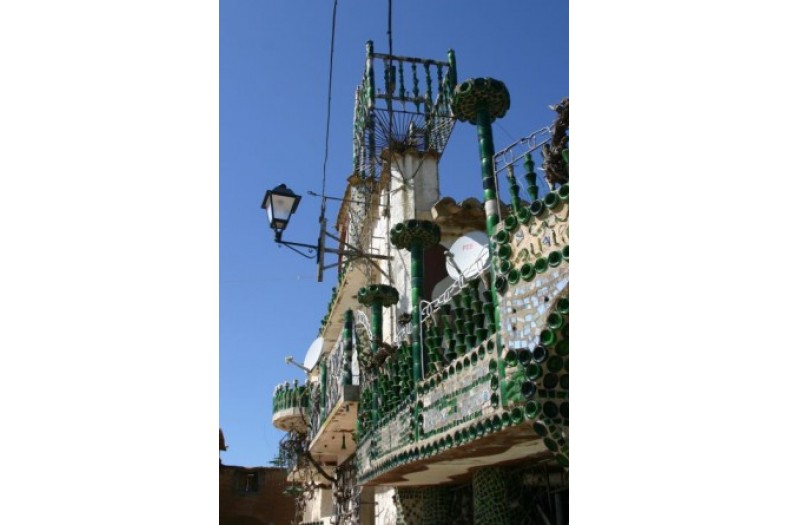La Casa de Cristál (The Glass House)Félix Sanpériz Gistau (ca. 1933-ca. 2009)
Threatened
Aragon, 22587, Spain
begun c. 1989
The intricate façade is viewable from the street; interior access is generally difficult, if not impossible, at the present.
About the Artist/Site
The approximately one hundred inhabitants of Monesma make their living from agricultural crops such as wheat, as well as from raising cattle. The village is so small that it shares a mayor and municipal offices with four other surrounding hamlets. Into this small community Félix Sanpériz, also known as Feliz, was born to a family of subsistence farmers, one of three children; all of them have since moved away. Félix was known as a bohemian and around 1989 he began fixing up the house in which he was born, a modest two-story whitewashed house overlooking the Val de Alferche plaza. At that time there was a bar on this plaza, and he began collecting their empty green glass bottles that held cava [Spanish sparkling wine], with the idea that he could use them to ornament his house and garden. Sanpériz was not a big drinker, so other people would also save their bottles and give them to him. The cava bottles tend to be thicker than conventional wine and beer bottles because of the need to contain the pressurized sparkling wine; when empty, the bottles are therefore more durable and serve better as a building material. It is said that Sanpériz thought perhaps one day he would open a restaurant in his house.
The entire building, inside and out, has been ornamented, not only with glass bottles—used whole and filled with concrete, or deliberately cut into larger sections and smaller shaped shards, later pressed into a concrete surface coating—but also with metal reinforcing rods and concrete irrigation channels, used as support to strengthen contiguous adorning structures or as decorative elements that stand on their own. The overriding aesthetic of almost all ornamentation in all sections of the house is curvilinear. This includes bold amoeba-like designs painted on the ceiling and around window and door openings on interior and exterior façades alike; low undulating concrete and glass walls surrounding built-in planter boxes, benches, and a pond; spherical discs spiraling up the sides of a fountain; and curved metal fences used as partitions and protection. In the house interior, amoeba-like shapes are painted seemingly randomly on walls, ceiling, and over the geometric tile work remaining from earlier residents; too, shelves, doors (the panels themselves as well as their lintels and jambs), cabinets, stairs, and ceiling components are also shaped in or adorned with these organic patterns.
Sanpériz worked practically nonstop on his house and garden for roughly nine years—until the money ran out, one neighbor said. Soon, although he had been born and grew up in Monesma, its scale became increasingly difficult for him. He sold his property to a local landowner and this new owner used it to house immigrants from Africa and Eastern Europe who work his fields. It is now, once again, for sale.
The intricate façade is viewable from the street; interior access is generally difficult, if not impossible, at the present. Perhaps things will change if the new owner of the property is more inclined to treat it as the special art environment that it is.
~Jo Farb Hernández, 2014
Contributors
Map & Site Information
, 22587
es
Latitude/Longitude: 42.193481 / 0.662168
Nearby Environments










Post your comment
Comments
No one has commented on this page yet.